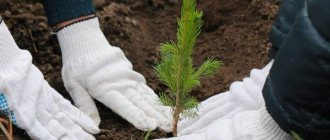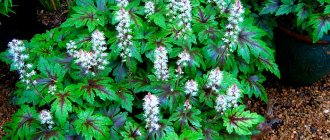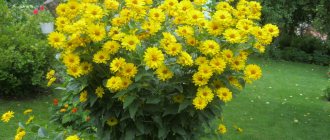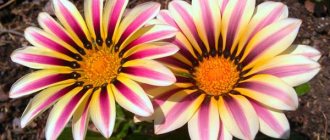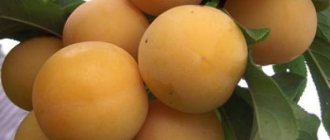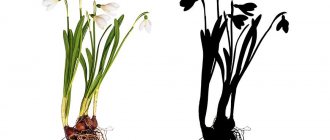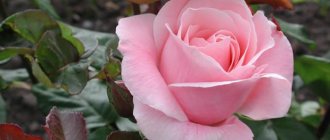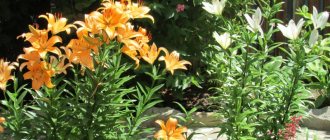Timing for planting in open ground
Rose seedlings are planted in the ground in spring or autumn; the exact timing depends on the climate in the region.
For the Moscow region and Central Russia, the approximate dates for planting roses are: April 20 - May 30.
In autumn, planting is carried out from September 10 to October 20.
In the Urals and Siberia, the planting dates for bushes are shifted by 2-3 weeks.
The third advantage of the floribunda group
Long flowering - some varieties bloom continuously, others have wave-like flowering with short periods of rest. It is very easy to choose varieties so that the rose garden smells fragrant and delights with flowers from spring to late autumn. Floribunda roses can accomplish this task gracefully and easily. Floribunda is profusely flowering, this is how the name of this group of roses is translated.
Floribunda roses can be successfully grown as cut flowers in a greenhouse; success is guaranteed if you select varieties with tall stems and continuous flowering.
How to choose the right seedlings
When choosing seedlings, take the strongest ones, with green, intact bark and a strong root system of the plant. A healthy bush should have 2-3 strong shoots. The root collar above and below the graft should be the same thickness and 5-8 millimeters in diameter. The roots should have many thin roots. Before planting, the roots of dried seedlings are immersed in cold water for a day.
New varieties
Today, more and more new hybrid types are appearing on the market, which according to their characteristics are classified as a group.
One of these types is the spray rose, which has the inflorescence as a separate bouquet. This bouquet type is very popular today and is well suited for cutting.
Another group that is still classified as the heroine of the article is the recently appeared mini-flora.
One of the American companies has developed a new group of flora-tea roses, which combine the best qualities of Floribunda and hybrid tea flowers. The main difference is that it is not inflorescences that develop on the main shoots, but new shoots with them. But they were never identified as a separate group.
In the 80s, low-growing plants with small flowers appeared, they were called patios. It is difficult to classify them as miniature, since the leaves and flowers themselves are quite large. Most often they are also classified as Floribunda.
Features of growing floribunda roses
A characteristic feature of floribunda roses is the formation of many buds on the bush, collected in inflorescences. Plants at any age require a lot of nutrients and strength, so the main task of the grower when growing roses of this group is to provide them with comfortable conditions.
Site selection
In order for floribunda roses to grow and delight with their flowering, you must first properly prepare the planting site.
The site should be well lit, protected from drafts and low (less than 1 meter) groundwater levels. The most suitable place for rose bushes will be the south side on a hill or slope. In the afternoon, the planted bushes should be slightly shaded. This prolongs flowering, protects against sunburn, fading of bud color and premature drying of shoots.
Suitable soil
Floribunda roses grow best in sandy clay or sandy loam soil. The soil should be loose and breathable. You can make the soil looser by adding a small amount of humus to it.
Before planting, the place where the seedlings will be planted is dug to the depth of a shovel. When digging, rotted compost (manure) and phosphorus fertilizers are added. Fresh manure is applied in advance; it must have time to burn out in the soil, since it can harm the plants during planting.
How to plant
The hole for the seedling is dug in advance, and the top fertile layer of soil is removed and deposited. The depth of the hole is determined by the place of grafting, which after planting should be 3-8 centimeters in the soil. The width of the hole is 60 centimeters.
A drainage layer of small pebbles, vermiculite, and expanded clay is poured onto the bottom of the hole, which will ensure the drainage of excess moisture.
The cut top part of the soil is mixed with rotted compost, rotted manure and phosphate fertilizers.
Dry, damaged shoots are removed from the roots of the seedling using a sharp and disinfected pruner. The main roots of the rose are shortened to 20-25 centimeters.
The seedling is installed vertically, the roots are carefully straightened. The soil is poured into the hole in portions and lightly compacted with your hands. There should be no voids near the roots after filling the hole.
After filling the hole, the root collar should be buried 5-8 centimeters.
After planting the plant, the ground is watered and the root area is mulched with fine straw, rotted humus, sawdust from coniferous trees or peat.
The above-ground part of the seedling, after planting, is shortened to 30-35 centimeters from ground level.
There is another way to plant floribunda roses, which reduces the possibility of the formation of air voids in the roots of the seedling.
To plant a plant, a hole is dug 30 centimeters deep and 60 centimeters wide.
A bucket of aqueous solution with sodium humate in the consistency of weakly brewed tea and a Heteroauxin tablet is poured into a prepared hole with drainage.
A seedling is placed in a hole with water. The plant must be placed in water up to the grafting level. The soil is poured and slightly compacted.
After such planting, no watering is carried out. The area around the seedling is covered with mulch.
In the first 1.5 weeks of growth after planting, the rose seedling needs to be shaded with spunbond, lutrasil, so that it is not exposed to direct sunlight. The protective material is then removed.
Features of planting floribunda roses in the ground in spring: video
What is floribunda
History of the origin of the variety
It is still not clear which of the two breeders - the Dane Svend Poulsen or the German Peter Lambert - is the author of the floribunda, but this hybrid appeared as a result of crossing hybrid tea and polyanthus roses. And the creator of more than sixty modern highly decorative varieties of floribunda, which are grown today all over the world, is the American scientist Eugene Berner.
Botanical description
From polyanthus roses, floribunda inherited a richness of colors and bud shape, and from hybrid tea roses - resistance to low temperatures, various diseases and pests. The diameter of flowers of this class reaches 4-8 cm. Simple, double, semi-double and densely double flowers can have a goblet or cup shape.
Floribunda bushes are characterized by a bouquet type of flowering, when many flowers form a large inflorescence. These roses bloom for a long time, abundantly, but in waves: the period of mass formation of flowers is replaced by a period of less intense flowering.
- How to prune hydrangea for winter
Plants of this class are striking in their variety of colors. A relative disadvantage of some varieties of floribunda is the lack of scent in the flowers. According to the height of the bush, varieties are divided into border varieties (up to 40 cm in height), medium-growing (from 60 to 80 cm) and tall-growing (from 1 m and above). Floribundas are planted along borders, as a tapeworm on lawns or in group compositions with ground cover and perennial herbaceous crops.
In the photo: Pink rose Floribunda
Caring for roses in the open ground
After planting rose seedlings in a permanent place of growth, they are provided with proper care, since the abundance of flowers, health and appearance of the bush depend on it.
Watering
For roses, abundant and timely watering is important. The soil under the bushes should always be slightly moist. Watering is carried out in the evening or early morning.
When watering in the evening, the settled water from a watering can, without a sprinkler, pours out in a stream to the base of the bush, into a small hole made around the plant. In this case, water should not get on the leaves.
Roses are watered with sprinkling only in the morning so that the moisture on the leaves has time to dry by evening.
In summer, the amount of watering gradually decreases, and in September it stops. This is necessary so that new shoots do not appear on the plant, which will weaken it during wintering.
If in the fall, several weeks before sheltering, there is no rain, you need to water the bushes 1-2 times a week, because you cannot leave roses for the winter without moisture in the roots, this will weaken them.
Feeding
Roses require regular feeding for full growth and budding of the bush.
If the soil is heavy, it is not advisable to fertilize roses in full.
Rose bushes are sensitive to salts contained in the soil. In heavy soil they are washed out with difficulty, so combined fertilizers are used in minimal quantities.
The bush is fertilized in the second year of growth. Feeding is carried out annually: in spring, summer and autumn.
In the spring, after the roses open, 60-80 grams of complex fertilizers are applied per 1 square area. Fertilizers are evenly scattered over the surface and incorporated into the soil with a rake.
In mid-May, when buds appear on the rose bushes, after watering or rain, the plants are fertilized with a solution of fast-acting mineral fertilizers (30 grams of fertilizer per bucket of water). 3 liters of solution is poured under one plant. At the end of June, nutrient watering is repeated.
At the end of October - beginning of November, potassium and phosphorus fertilizers (which do not contain chlorine) are scattered over the surface of the earth, 30 grams of each fertilizer per 1 square area. If rose bushes are sheltered for the winter by raking soil over them, additional fertilizers are applied after covering the bushes.
Mulching
Roses need loose soil, where heat, moisture, and air penetrate without much difficulty. Regular loosening of the soil saves water for watering and fertilizing. With deep loosening there is a possibility of damage to the roots. To prevent the soil from compacting, it must be loosened to a depth of no more than 10 centimeters or covered with mulch, which will retain moisture in the soil.
Mulching is carried out after watering and feeding the bush. For mulch, pine needles, last year's sawdust of coniferous species, chopped straw, peat, and rotted humus are taken. Mulch is scattered in an 8-10 cm layer around the bush.
Trimming
Pruning roses is a mandatory procedure for the full growth and flowering of bushes. It is carried out in spring and autumn, before covering the plants. In this case, dry, frozen, thin stems are removed. The strongest shoots remain.
When pruning in spring, 3-5 stems should remain on the bush. The remaining branches are additionally pruned to a height of 4-5 buds (stems about 10 centimeters long should remain from the ground). If there are shoots on the sides, they are also trimmed.
Floribunda rose - pruning, growing features: video
Popular varieties and their descriptions
The varietal diversity of floribundas is great. But there are a number of roses that are most popular among gardeners, their names and brief characteristics:
- Stromboli - the height of the bush is about 80 cm. The leaves are shiny, deep green. The flowers are cup-shaped, double. The inflorescence has from 3 to 10 buds, the petals are grooved. The aroma is weak, flowering is abundant and long lasting.
- Lilly Marlene - 70 cm, green leaves with a bronze tint. The flowers are slightly double, the color is bright red. The smell is strong.
- Bluevender is a spreading shrub about 60 cm. The leaf blades are dark green with a glossy surface. The flowers are medium-sized, double, pink with an orange tint.
- Blue for you - the rose is unique in its color, blue and lilac. The shape of the flowers is also unusual; even when open, they resemble buds that are not fully ripe. Reaches from 80 to 90 cm, blooms until mid-October.
- Galaxy is an 80-centimeter beauty with two-color petals, yellowish and light burgundy. The peculiarity of rose is its aroma, which is similar to the smell of linseed oil.
- Raffles Dream is one of the most unusual and popular roses. It stands out strikingly with its large and lush buds. Its petals are attractive - they are corrugated, cut along the edges. The color of a rose can be very different. But such beauty is not without its drawback - the rose is prone to fungal diseases, which requires careful and regular prevention.
Rose Sympathie - variety description
The updated edition of the rose catalog includes a separate species of floribunda - Spray rose. These are plants not exceeding 50 cm, studded with many small buds with a diameter of 4 to 7 cm.
Additional Information! Frisia has the longest flowering period with yellow flowers that do not fade in the sun. Flowering lasts until frost.
Blue for you - a rose for those who want to effectively highlight their garden
How to propagate correctly
Roses reproduce well from cuttings. At the same time, lignified shoots are cut from the bush. They take root in the fall or are stored until spring and planted later.
For planting, cuttings are cut at a right angle at the top and at a 45 degree angle at the bottom. The upper cut is treated with ash or crushed activated carbon, and the lower cut with Kornevin.
The cuttings are buried in the prepared soil and covered with a two-layer non-woven fabric or cut plastic bottles.
The cuttings grow on the planting site for 2 years; in the 3rd year, the grown bushes are planted in a permanent place.
Rule No. 8: Feed your roses in a timely manner
It is very important to fertilize roses correctly throughout the year. You need to start fertilizing from the second year of the plant’s life.
- After pruning, before the leaves bloom, and two weeks after that, feed the roses with ammonium nitrate (30 g per 1 sq.m.) or organic matter: mullein diluted with water (1:10).
- During the period of bud formation, roses will benefit from a complex mineral fertilizer for flowering plants, such as Agricola or Fertika.
- Before the first flowering, feed the roses with mineral fertilizer: dissolve 1 tbsp in a bucket of water. potassium sulfate, the same amount of Agricola rose fertilizer and 2 tbsp. nitrophoska.
- After the first flowering, feed the roses with complex mineral fertilizer (see the dosage on the label). Remember that from August you should not feed plants with nitrogen fertilizers.
- In autumn, fertilizing with potassium salt and superphosphate (30-40 g per 1 sq.m.) is acceptable. Fertilizers during this period should not contain chlorine.
Protection from diseases and pests
Floribunda roses, despite their high resistance to diseases and pests, if they are not properly cared for, they, like other types of roses, although to a lesser extent, also begin to get sick or become covered with pests.
Diseases
Black spot
When affected by the disease, black spots form on the leaves, they turn yellow below, dry out and crumble. Spotting usually appears in mid-summer, with the disease peaking towards the end of summer.
The disease appears due to sudden changes in temperature and high humidity.
Regular spraying of bushes with horsetail decoction or nettle infusion prevents the occurrence of this disease.
When affected by the disease and for prevention, the following drugs are used: Profit, Ridomil Gold, Skor, Topaz, Fitosporin.
Diseased leaves on the bush are torn off and destroyed.
Rust
In spring, bright orange tubercles appear on young shoots and leaves due to this disease. Over time, they darken and grow. The disease weakens the bush.
The spread of the disease occurs due to high air humidity, and in hot, dry weather the development of fungi is inhibited.
You can fight the disease with the same drugs that help with black spotting.
Additionally, affected bushes are heavily pruned in the spring, and removed shoots are destroyed.
With a high degree of damage, the bushes are dug up and removed from the site.
Powdery mildew
The disease appears in cool, damp weather. A whitish coating appears on young shoots, leaves and buds.
The appearance of the disease is facilitated by a lack of light, an excess of nitrogen in the soil and thickened plantings.
At the onset of the disease, dusting with wood ash helps. The bush is sprayed with water and sprinkled with ash on top, after 2 hours everything is washed off.
In case of severe infection, antifungal drugs are used. First, before processing, all diseased leaves are removed from the bush.
Pests
Bronzovka
Large golden-green beetles eat the petals, stamens and petals of roses. Pests are removed manually in the early morning while they are inactive.
Green rose aphid
Pests settle in colonies at the bottom of leaves, on green shoots, peduncles, and buds. They suck the sap, weakening the bush. The shoots of affected roses become bent, the leaves curl, and the buds do not open.
At the initial stage of infection, a decoction of wormwood, an infusion of garlic, tobacco, hot pepper, yarrow, and tomato tops with the addition of a soap solution are used when spraying. If there are a lot of pests, insecticides are used: Fitovera, Inta-Vir, Actellik, Fufanon.
Roseate sawfly
The black-brown pest resembles a bee. Its whitish larvae and light green caterpillars are considered the most dangerous for the plant. They eat away the passages in the stems, eat the buds and flowers. To combat the pest, damaged shoots are cut out and burned.
Rule #3: Use a well-lit area for planting.
Floribunda roses love light, so for planting it is important to choose a well-lit place (south, southeast or southwest side of the site), protected from drafts. To prevent the buds from burning out and drying out prematurely, be sure to shade the bushes in the midday heat.
When planted in a shady place, roses may stop blooming altogether, and black spots will appear on the leaves. And powdery mildew, which also appears in a shady and damp place, can greatly spoil the life of both you and the plant. Roses also do not like close proximity to groundwater.
Roses have no special preferences regarding soil - the main thing is that it is breathable and loose. If you have clay soil, add sand or peat to it, and if sandy, add organic matter.
Shelter for the winter
Before covering the bush for the winter, it needs to be prepared. The shoots are pruned, leaving no more than 40 centimeters from the surface of the earth. All leaves are removed from the bush.
The bush is covered with earth up to 20-30 centimeters in height and covered with spruce branches, fallen oak leaves or a wooden or metal frame using covering material. After the first snowfall, the plants are additionally covered with snow crust to retain heat inside the shelter.
A covered rose tolerates winter well and grows new shoots in the spring immediately after removing the protective material. The shelter is removed in March or April (depending on regional climate conditions).
Rule #6: Pruning on time
Pruning floribunda roses stimulates abundant flowering and the growth of basal shoots. Some shoots are pruned heavily, while others have only a small part of the stem removed.
Pruning of adult floribunda rose bushes is carried out 3 times a year:
- Spring pruning: after planting, in subsequent years - before the start of sap flow (in the first half of April). Shorten all one-year-old shoots of bushes by a third, and leave 3-5 buds on two-year-old ones. Also, during spring pruning, you can completely remove old shoots that thicken the bush.
- Summer pruning: its purpose is to stimulate flowering. Remove all faded inflorescences from the plant.
- Autumn pruning: remove old, undeveloped branches and leaves for successful wintering of the rose.
